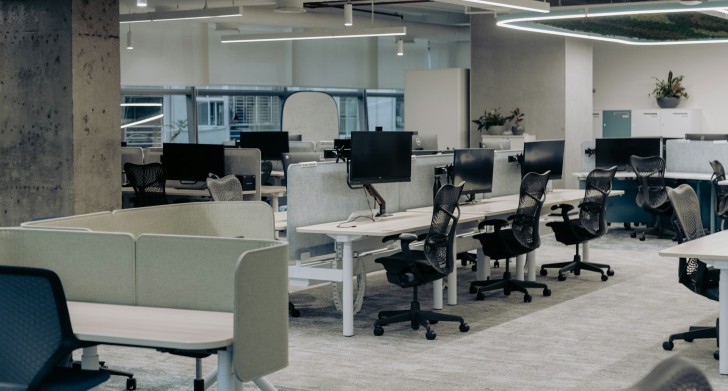- The overlooked driver of engagement
- The link between environment and employee behavior
- Comfort, accessibility, and well-being as engagement foundations
- The role of privacy and shared space balance
- The importance of design consistency and identity
- Investing in upgrades that strengthen engagement
- Integrating technology and flexibility
- Sustainability and responsibility as motivators
- Continuous improvement and feedback
- Conclusion
The overlooked driver of engagement
Workplace engagement often focuses on communication, recognition, and management, but the physical space is an equally strong influence. A cluttered or uncomfortable environment can undermine even the best leadership efforts. In contrast, a well-organized, inviting workspace encourages focus, trust, and cooperation.Employees who feel comfortable and supported by their surroundings are more likely to stay motivated and contribute actively. The workplace itself becomes a daily reminder of a company’s priorities and respect for its people.
The link between environment and employee behavior
Physical surroundings affect energy, attention, and collaboration. Bright, natural light boosts alertness, while poor lighting causes fatigue. Open, clean layouts improve communication, while cramped or noisy spaces create stress. Even color choices can influence mood; warmer tones promote creativity, and cooler tones improve concentration.Research continues to confirm this link. Companies with well-designed offices see higher engagement, fewer absences, and lower turnover. The environment quietly shapes behavior, guiding how employees work and interact throughout the day.
Comfort, accessibility, and well-being as engagement foundations
Comfort is not a luxury; it is essential for consistent performance. Ergonomic furniture reduces strain, balanced lighting reduces eye fatigue, and stable temperature control prevents discomfort. When these basics are in place, employees spend less energy managing their surroundings and more energy on their work.Accessibility also matters. Inclusive spaces that accommodate different physical needs show respect for all employees. This sense of inclusion builds connection and loyalty. A workspace that supports both body and mind sets the foundation for sustained engagement.
Engaged employees need flexibility. They need quiet zones for focus and shared spaces for teamwork. When offices provide both, collaboration improves without sacrificing concentration. Poorly designed layouts often create noise and distraction, leading to frustration and lost time.Small design choices have big effects. Clean, private restrooms, for example, contribute to professionalism and comfort. Upgrading facilities with durable Hadrian toilet partitions enhances privacy and cleanliness, reinforcing respect for employees. When people feel the environment supports their needs, engagement naturally rises.
The importance of design consistency and identity
A workspace is a reflection of company culture. Consistent design through colors, materials, and layout communicates stability and purpose. It reminds employees of what the organization stands for. A cohesive environment fosters pride and belonging, making employees feel part of something organized and intentional.Visual consistency also supports focus. When spaces are designed with care, they reduce cognitive noise and help people stay aligned with company goals. A strong physical identity supports a strong emotional connection.
Investing in upgrades that strengthen engagement
Workspace improvements are not just cosmetic; they are strategic. Upgrades directly affect morale, productivity, and retention. Businesses moving or renovating should prioritize design elements that improve comfort and performance. For guidance, review practical commercial premises upgrades that modern workplaces benefit from most.Key improvements include better lighting, improved acoustics, efficient layouts, and sustainable materials. Even minor adjustments like reconfiguring meeting spaces or adding plants can improve satisfaction and reduce stress.
Integrating technology and flexibility
Today’s workspaces must adapt to hybrid models and evolving needs. Smart systems for lighting, air quality, and room scheduling simplify daily routines and reduce frustration. These technologies create smoother experiences without adding complexity.Flexible furniture and movable partitions allow spaces to shift as teams grow or projects change. Technology should enhance comfort and access, not overwhelm users. When designed well, it integrates naturally into the workflow, making employees’ lives easier and their engagement stronger.
Sustainability and responsibility as motivators
Employees increasingly value sustainability. A workplace built with environmentally responsible materials and energy-efficient systems shows long-term thinking. Green design supports engagement by aligning company practices with modern employee values.From recycled materials to natural light optimization, sustainable spaces improve both morale and efficiency. Employees take pride in working for organizations that minimize waste and invest in the future. Responsible design also reduces operational costs, creating stability that benefits everyone.
Continuous improvement and feedback
Workplace design should evolve with the organization. Continuous improvement means listening to employees and studying how spaces are used. Surveys, data analytics, and observation reveal what works and what does not.Adjustments do not always require major investment. Small improvements, such as adding quiet corners, upgrading lighting, or improving airflow, can yield measurable engagement gains. The key is maintaining a mindset of adaptation and responsiveness. When employees see their feedback reflected in real changes, they feel heard and valued.
Conclusion
Employee engagement begins with the environment. A workspace that supports comfort, privacy, and collaboration turns daily work into a positive experience. Design decisions signal company values and shape how employees connect with their tasks and each other.By investing in thoughtful layouts, durable materials, and flexible technology, businesses strengthen loyalty and productivity. The physical workspace is more than a backdrop; it is an active tool for engagement, satisfaction, and long-term success.
 Editorial staff
Editorial staff

 Editorial staff
Editorial staff


